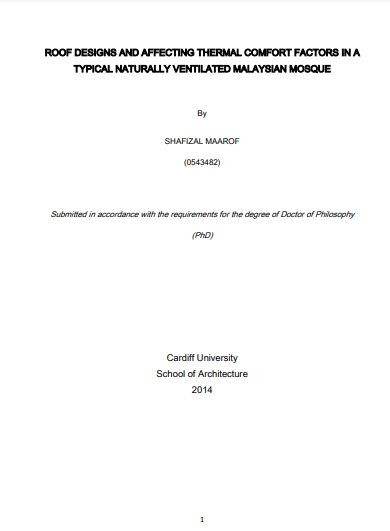
The local climate of Malaysia with high air temperature and relative humidity and inconsistent air movement throughout the day provides challenges for architects and designers to design a building including a mosque that can provide better indoor thermal condition. Thermally uncomfortable indoor environment in a typical Malaysian mosque can be sensed due to the poor attendance of believers during communal prayers conducted five times a day at the mosque. A study was carried out in four typical mosques in Malaysia to investigate the thermal comfort level together with what and how the thermal comfort factors affecting the condition. They study also looks at the influence of roof design of the mosque in affecting thermal condition inside the prayer hall since the roof design is a significant feature of the building not only as a filter to the outdoor climate but also as the identity of the building and the society. From the investigation, it has been revealed that air temperature is the primary factor in affecting thermal comfort. When the air temperature is at neutral or comfort temperature, the presence of other factors can be ignored. However, when the primary factor is no longer at its neutral condition, the secondary factors which are air movement and humidity will play their roles in influencing thermal comfort in naturally ventilated mosques in Malaysia. In many cases, air movement is always desirable and able to improve the thermal comfort level. Therefore, the need for the availability of air movement should be particularly considered in designing a mosque to ensure that the mosque is thermally comfortable. The research has also discovered that the pitched and doomed roofs have different abilities to control the distribution of air, for examples, the pitch roof mosque has the ability to circulate the air inside the prayer hall to achieve the equilibrium state whereas the domed roof mosque has the ability to stratify the air according to the temperature where the coolest air located at the lowest level of the space. With the pitch roof, a mosque is able to create air movement inside the space whereas the dome roof mosque will provide stagnant but cooler air at the active level due to the stratification process. Due to these findings, the pitched roof mosque is considered a better option for this climate for its ability to provide natural air circulation inside the space which is desirable by the users. With the understanding on the ability of the roof designs namely, domed and pitched roof in controlling air movement of the interior and the interdependencies of the main factors affecting thermal comfort, strategies for improvement on the design of the mosque can be made to achieve better indoor thermal condition of the prayer hall.
Maarof, S., ‘Roof designs and affecting thermal comfort factors in a typical naturally ventilated Malaysian mosque’ (Unpublished doctoral thesis: Cardiff University, 2014).
I agree to the terms outlined below:
You agree to upload and assign Mosqpedia Database the rights to use the content worldwide and in perpetuity across all current and future media platforms. Mosqpedia Database may edit, copy, adapt and translate your contribution.
The content will be distributed under the Creative Commons Attribution-Deed – Attribution-NonCommercial-NoDerivatives 4.0 International – Creative Commons
All data will be stored in line with data protection regulations.